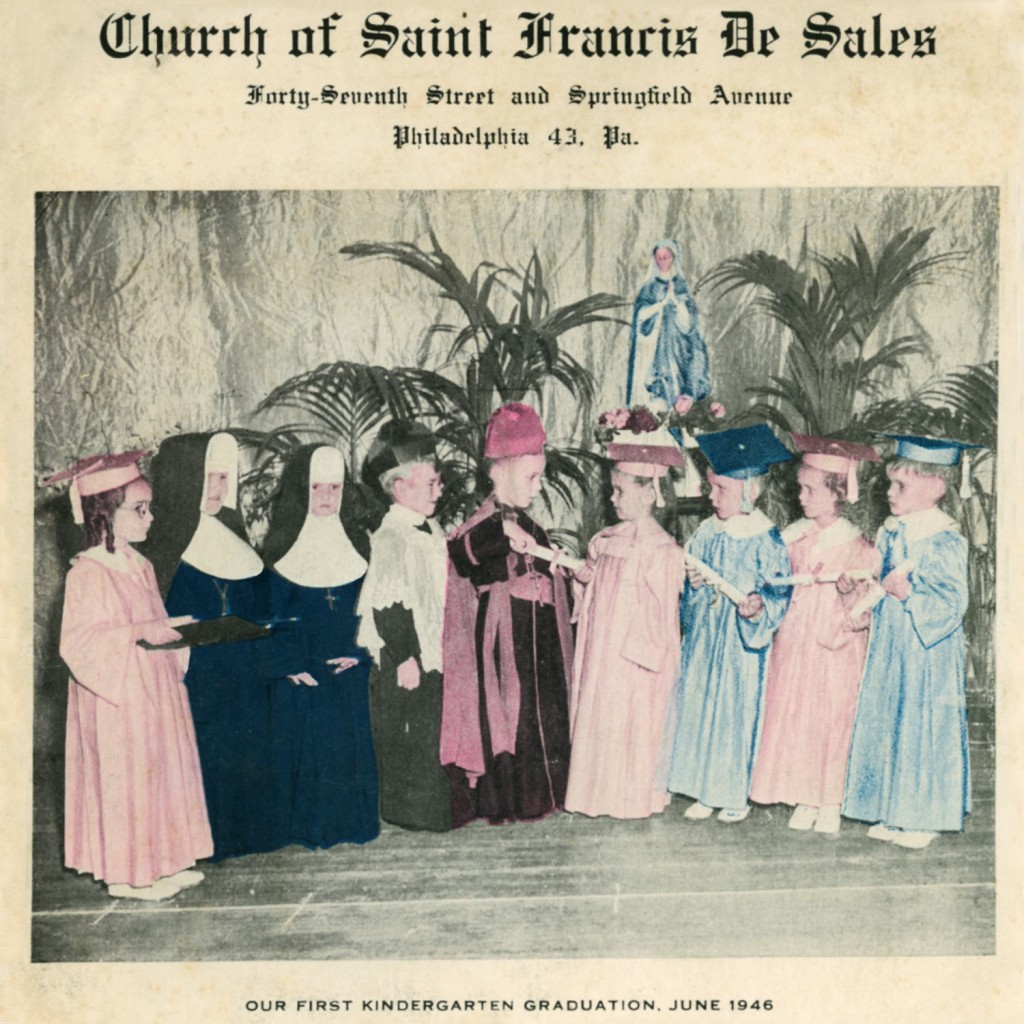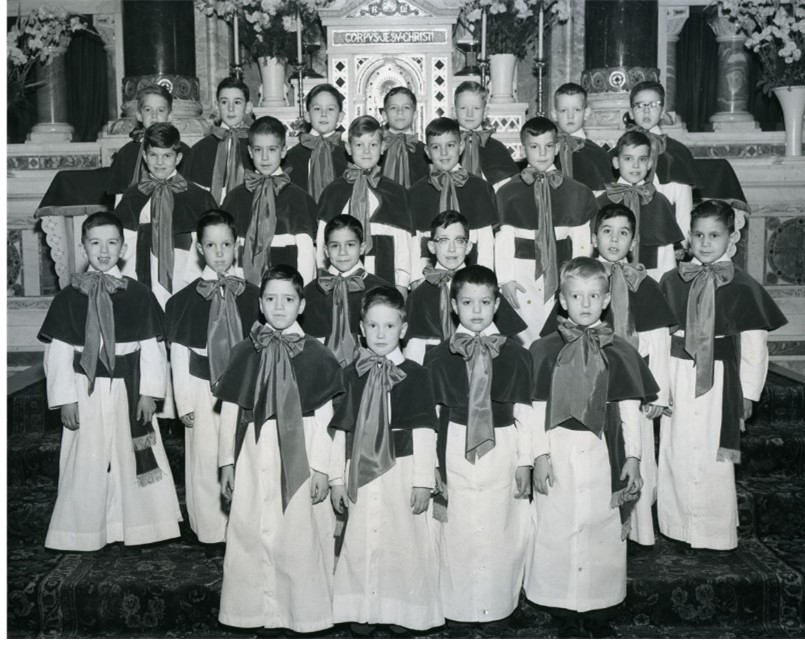



The Christmas season actually begins nine months ahead of December 25, with a mysterious event that can only be explained in symbols — and which attains added significance when viewed through the glass of our window.
The Annunciation window on the parking lot side of SFDS church, crafted by the studio of Nicola D’Ascenzo about 1910, celebrates the startling moment when Mary found out that she was to be the human Mother of Jesus. Its design was inspired by symbol-rich 15th century Northern European Renaissance paintings such as those of Jan van Eyck (left. “The Annunciation” ca. 1434-1436), Hans Memling (center. “The Annunciation,” ca. 1465-1470) and Rogier van der Weyden (right. “The Annunciation” from the Saint Columba Altarpiece ca. 1455). Serendipitously, its thematic elements echo the decoration of the church built around it, making the scene relatable to all those sitting in the pews, while the medium of stained glass adds an extra dimension of meaning.
It begins with the familiar setting. Art historian Christopher Jones notes that in the 15th and 16th centuries, “Northern European artists…often showed the Virgin in an interior space, sometimes…an ecclesiastical context, drawing on contemporary Gothic styles to suggest the familiar setting of the Christian Church.” In our window, rather than showing medieval pointy Gothic arches, Mary’s church features the same elaborate round-topped windows and linked-chain and Byzantine lozenge decorations as the 1911 Byzantine-Romanesque church constructed around it.

The presence of a dove, representing the Holy Spirit, is the usual convention to symbolize the moment of conception. Jones observes that “In Annunciation paintings, the dove is often shown descending on a ray of light, indicating …a sense of movement or passage, with the ray of light touching the Virgin’s head or breast in the moment of Incarnation.” This is how it’s shown in the window. The idea is presented again in the sanctuary of the church, with a dove mosaic pointing down above the statue of the Blessed Mother.
Jones observes “One fascinating tradition that developed in early Netherlandish art was to show the ray of light entering the scene through a window, as in Rogier van der Weyden’s painting. This was a way of alluding to the conceptually tricky idea of Mary’s miracle conception, by comparing the passage of the Holy Spirit through the body of the Virgin to light passing through glass.” Our Annunciation window actually becomes a double Holy Spirit reference – rays of light from the dove beam into Mary through an image of a window, painted on an actual glass window—so that the light of the dove, shining through the Blessed Mother, reaches us, too. The “Holy Spirit as a dove in a window” theme recurs in two dove windows in our dome – one showing the dove descending into the church bringing grace from heaven, and another ascending from the church, to carry prayers heavenward — the Holy Spirit passing through the glass in both directions.



Since the Feast of the Annunciation is celebrated in the Spring, nine months before Christmas, Jones observes that paintings often include garden references. He notes that in Northern Renaissance artwork, like that which inspired our window, “The motif of a flower in a vase became well-used, a tradition that developed into a lily, which became the symbol of the Virgin’s purity.” Our window shows a lily in a pot in the foreground – which would have echoed the multitude of cut flowers used to adorn the church, as well as the single lily in one of the dome windows. Since the lily also represents Christ in the Passion, it brings a poignant note into the scene — appropriate since the March feast occurs during Lent, overlapping with that more solemn season.
As in many of the Northern Renaissance paintings, the Archangel Gabriel in our window wears a lavishly patterned gown with a large jewel clasp at the neck, Art historian Isabella Meyer notes that the opulence of a similarly attired angel, in a painting by Van Eyck, evokes heavenly richness and observes that “His garments also suggest that he is taking part in or celebrating High Mass” – an interesting observation – our angel’s elaborate garments would have mirrored the pageantry of high Masses inside the church when the window was installed.
Our Archangel Gabriel is equipped with a lily staff embellished with the words “Ave gratia plena,” or “Hail favoured one.” The Dictionary of Subjects and Symbols in Art notes that Gabriel’s prop evolved in artwork over time: “In early examples the angel holds a scepter tipped with a fleur-de-lys, the attribute of Gabriel, but later it often holds the lily.” The transformation from sceptre to lily offers an interesting meditation. A sceptre would symbolize royal favour while the lily flower symbolizes purity. Gabriel’s lily staff is an invitation — or a mandate — to the Virgin from God — but a similar lily staff, shown on the St. Joseph tabernacle in our church, references Jesus’ earthly lineage: “And there shall come forth a rod out of the stem of Jesse, and a Branch shall grow out of his roots.” So the small detail of the staff can be a reminder of Christ’s dual nature: his divinity, in the recognition of God’s favour; and his humanity, based on his earthly lineage. This thought is repeated with the pair of fleur-de-lys/lily crosses under the Nativity window.
As in many Renaissance depictions, a statue of David appears near Mary in the window scene as a reminder that Jesus was both God and human (and Jewish!) — the same message as the mosaic Stars of David in the church dome, both offering a link to the Old Testament and a reference to Jesus’ family lineage as part of the House of David. Double cross symbols in the lower panels of all three windows on that side of the church to reinforce the concept of the Incarnation — the notion that Jesus had a dual nature that was both divine and human.



Finally, the Dictionary of Symbolism offers the interesting idea that Mary’s words of response to Gabriel’s invitation, sometimes included as a “speech balloon” in Renaissance Annunciation paintings, “may be upside down so that it can be more easily read by God the Father.” Curiously, the Old Testament prophecy of Isaiah, written above our Annunciation window, and which translates from the Latin as “Behold, a virgin shall conceive…and his name shall be called Emmanuel,” shows the word virgo, or virgin, upside-down. This could have been a reference to that historic practice — echoed by the symbol of the Eye of God shown peering down into the church through the oculus window of the dome.
Viewed as a group, the three windows on the parking lot side of the church celebrate the Christmas season with heavenly light, representing God’s grace shining symbolically through a window in each design. The Holy Spirit dove illuminates the first scene; and the nativity star, representing the light of Hope from above, gleams above the birth. In both instances, the light from the painted window shines into the church through the glass of the actual window. The third scene, of Christ’s youth, is a darker vision, foreshadowing his future as he builds a cross in his father’s workshop. That scene also includes a little piece of a painted window in the background, obscured by the cross and a red rose — another flower that symbolizes both Mary’s purity and Christ’s passion. The story then continues across the aisle with the three windows of the Easter season, commemorating Christ’s adult ministry, all shown outdoors, ending with the Agony in the Garden.
The story of Christ, as told in the windows of our church, invites us to find our place in the rhythm of historic continuity — from the Old Testament to the New; from Christ’s Birth to his Resurrection; from Renaissance artwork to the construction of our church in the early 1900s, to the present day; from an interior life to a worldly ministry; from darkness to light in an endless annual cycle of death and rebirth. And through it all, we are called to reflect on the miracle of God’s continuing presence, symbolized in the light shining through the bright rainbow glass, illuminating history and touching everyone who pauses to look.




This Christmas, before entering the church, take a moment to notice another depiction from Christ’s early life, now revealed with the removal of the scaffolding: a weathered bas relief outside, by the front door, of “The Flight into Egypt.” Crafted by Italian immigrant sculptor Adolfo de Nesti, it shows the Holy Family desperately fleeing a dangerous situation at home to seek refuge in a foreign land in a time of trouble — one more family, part of another endless historical cycle that is all too relatable for too many people across the globe this holiday season.
The Holy Family’s urgent movement — and the travels of Jesus who never stayed in one place — are a reminder that faith is a journey. Pope Francis, in his pre-Christmas address to the Roman Curia, cautioned that “it is important to keep faring forward, to keep searching and growing in our understanding of the truth, overcoming the temptation to stand still and never leave the ‘labyrinth’ of our fears.” Christianity “is not meant to confirm our sense of security, to let us settle into comfortable religious certitudes, and to offer us quick answers to life’s complex problems.” The Pope “concluded with a call to courage, love, and humility in our journey of faith and service” and asserted “Only those who love fare forward.”














































